
The Method Behind the Madness
It is 9am and already sweltering hot. I frantically grab random objects from my small apartment: a frypan, a hat, a scarf, a soup spoon and a boomerang (just happened to have one in my backpack) in preparation for today’s clowning workshop with the Kazenoko Company Actors. I am usually very comfortable these days in the role of clown master and have conducted hundreds of workshops with a wide variety of people since studying clown with Philippe Gaulier (French Clown Master) at his school in 2000/ 01, however, today I am a little nervous because I will be running the workshop in Japanese.
Prior to the workshop I have studied up on essential new vocab such as ‘Dokeshi’ (clown), ‘Mujaki’ (Innocent), ‘Kurikaishi’ (Routine), ‘Kusuguru’ (Tease out the laugh), ‘Kiwadori’ (Hit and miss) and ‘Ochi o toru’ (Punchline) but more than not being understood, I am worried that I might be teaching the actors things they already know. The Japanese have a natural comic ability, largely because they are a country that has a long comic tradition and still greatly respect and celebrate their comedians.
`Manzai’ (Comedy Duos) are the most popular form of comedy in Japan these days, unlike Australia/ America where the Stand Up Comedian is king. These comic duos do everything from ‘mono- mane’ (Imitations), to `kanto` (improvisations) to sketch comedy. Successful comedians in Japan can become big stars and go on to build careers not only as TV personalities but also as serious actors in TV series and films. But ‘Manazai’ has not always been popular in Japan. In fact when it was first introduced in the 1920s, audiences hated it. Up until that time, audiences had only seen ‘Rakugo’, which is the traditional form of comic story telling. ‘Rakugo’ is performed solo, in old style dialect, wearing traditional dress and sitting down and is still very popular in Japan today. Hanabishi Achako- san was the first ‘Rakugo’ artists to try standing and delivering his routine at the Yoshimoto Theatre in Osaka but apparently, the audiences didn’t like it at first. Then the more radical ‘Rakygo’ artists decided to try it in pairs but the stories were long winded and it still didn’t work. And finally, they tried adjusting the content to make the subject matter more accessible (marriage, food, drinking, children etc) and delivered each subject in bite -sized chunks before hitting the punch line and moving on to the next topic. Very much like stand up comedy, only delivered in pairs and evolved completely separately.
Switch on the television in Japan and to the untrained eye it looks like a bunch of people doing crazy things, laughing at each other and throwing themselves around. In actual fact there are a wide variety of comic formulas at play that are key to clowning. For example, if your friend attempts a gag, it is your job to laugh (either with or at your friend…what ever you honestly feel at the time). If the gag falls flat, acknowledge the fact that it bombed. Or as Philippe Gaulier would say “Ahhhhh! Someone is here- someone is with you! It is your old friend, Mr Flop. Play with him.” And other clowning essentials such as if you do something that gets a laugh, do it again, and again until it doesn’t work; then remember it for later and bring it back to save the show!
The Kazenoko rehearsal space is a little out of town so we all meet at the office in down town Fukuoka and pile into the touring vans. We arrive and enter the space, my curious eyes scan the organised chaos of every spare inch of wall from floor to ceiling. I spy set, prop and costume items from the various shows ‘Furato Burato’, ‘Nande Man’ and ‘Toppinshan’. The actors have already changed into rehearsal clothes and are stretching. I join in and discover that this bunch like a thorough warm up.
The highlight of the warm up was getting them to do tongue twisters in English. Next time you meet a Japanese friend, get them to teach you one of their ‘Hayaguchis’ and you can teach them yours. I recommend “Red Leather, Yellow Leather”- You’ll have each other in stitches in no time.
Then I introduced the group to ‘Simon Says’. Anyone who has played this with Gaulier, or a student of his school will know that it is no ordinary game of Simon Says and at the end of the game everyone must add up their mistakes and decide if they want hits, kisses or ‘nothings’ for their mistakes. The hits are issued unforgivingly on the head (by the clown master) and the kisses are negotiated with fellow group members, but if someone says ‘no’ to giving you a kiss, you will be issued hits instead. It is a very funny game and goes a long way to breaking the ice and establishing relationships between fellow performers. Interestingly enough, most of the Japanese actors opted for kisses, which is surprising in a society where a kiss or a hug is rarely exchanged between friends…as opposed to in Europe.
Warmed up and ready to go, I issue the group with red noses and we move into a series of clown training exercises drawing from Philippe Gaulier and another director that I trained with in England, John Wright.
Highlights included Tamaki and Jiro-san’s very funny routine with a boomerang (the clowns have no idea what a boomerang is and end up using it as a back scratcher) and Jun, Yuji and Daichi trying to convince the audience they are identical triplets (when they look nothing alike).
It was a great chance to share skills with the Kazenoko performers and confirmed my belief that the Japanese are gifted comedians.






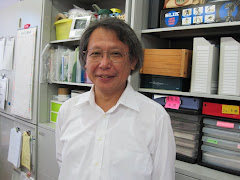
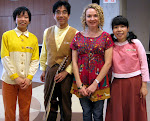
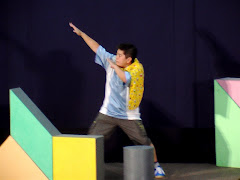



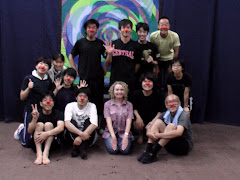


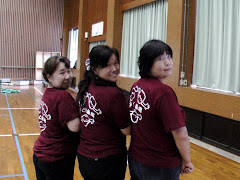

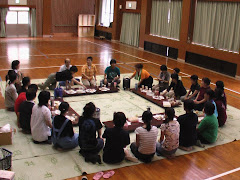
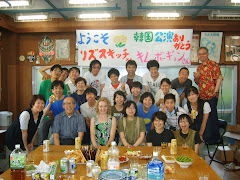

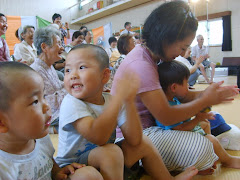

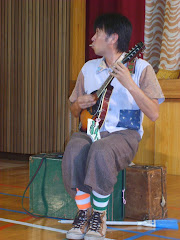


No comments:
Post a Comment